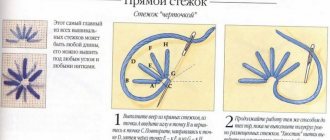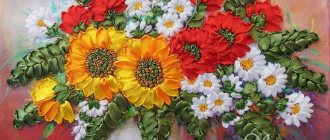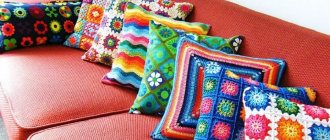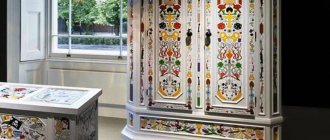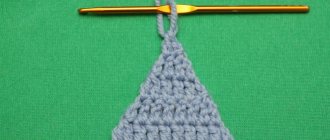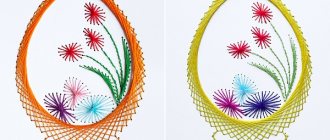Embroidered work in the Rococo style will fit perfectly into almost any interior. The article provides a master class on the basic stitches used in this style of embroidery. Several completed works are also presented. Enjoy reading!
208 0
Welcome everyone to my master class! Rococo means "curl" in French. It is assumed that the embroidery will be done with twisted twisted seams. Sometimes there is a mention of Brazilian technology. The Rococo embroidery style is used mainly for floral and plant motifs.
It can often be found on knitted fabric, for example, blouses, mittens, scarves. Decorative interior details such as napkins or tulle are decorated. A miniature embroidered picture on linen gift bags produces an impressive effect. A pincushion with Rococo embroidery will be an original gift. Unlike classic biscornu, you can zone the surface with three-dimensional patterns separately for pins and needles.
Features of the Rococo style
A special feature of the Rococo technique is the seam, which is made using turns on a needle . They give volume. Threads and ribbons are suitable for this type of embroidery. The needle must be selected carefully. The thickening in the eye area will not allow the formation of an even seam, so for thin threads it is better to use a bead needle that does not have thickenings. If you embroider with woolen thread or floss in several layers, any needle will do.
Rococo is best suited for embroidering plant motifs - double flowers, petals - since the stitches are voluminous and rounded, which is not relevant for an ornament with its clear patterns.
Are you planning embroidery on
a painting or clothing
Master class on embroidering spikelets from satin ribbons
Often, when embroidering large compositions with a sufficient number of flowers, field flowers are an integral part of such paintings. Many different flower crops grow in our fields, and accordingly, very often in paintings you can see spikelets of wheat inserted into a flower arrangement. Now we will tell you how to embroider spikelets for your painting to create a field bouquet.
In order to embroider spikelets you will need to prepare:
- Satin ribbons in two colors: bright yellow and pale yellow. The width should be 50 and 30 millimeters.
- Floss threads of rich yellow color.
- Embroidery needle.
- Hoop.
- Scissors.
- Matches or lighter.
- Canvas. For beginners, it is better to use it to master embroidery techniques.
Work execution algorithm
So, after you have prepared all the materials for work and have some free time, you can start doing our embroidery.
- We take a ribbon 50 millimeters wide and tie a knot at the end, but first of all, of course, we burn the end of the ribbon.
- We thread the needle into the canvas that was previously inserted into the hoop. We carefully press the knot on the wrong side of the material and thread the needle through the front side.
- We straighten it with the front side up and form one side of the grain: we stick the needle inside the canvas and thread it through, so we get one side of the grain.
- Try not to tighten the tape too much: when it enters the material, a beautiful notch involuntarily forms on its surface, and then a less wide tape will pass through it. She must definitely show off in our picture.
- In this way we embroider the grains of the spikelet, slightly reducing their size towards the tip. To make it more clear and simpler, at the beginning of this long journey, you can draw a sketch on the canvas with a simple pencil and embroider our grains along the lines.
- Now we take a lighter ribbon 30 millimeters wide and begin dubbing the grains, but inside the embroidered wounds in the same way as we did before. We will get a beautiful grain that is more voluminous and bright.
- Now we take the floss threads and embroider the stalk of the spikelet, not very large.
- And also let’s not forget that the spikelets have small fluffy branches from the grains. We also embroider them using the threads that were used to form the stem.
In this simple way we can create a magnificent composition of wildflowers and ears of wheat in our painting.
https://youtube.com/watch?v=05BrqyXoxl4
Stitching technique
The Rococo technique uses several stitches that appear differently in the painting: loops, spirals, stitches and knots .
Stitch
The rococo stitch is done like this:
- Mark two points on the fabric , the distance between which will be equal to the length of the stitch.
- Pierce the first point from the wrong side and bring the needle to the front side.
- Pierce the fabric at the second point and bring the needle to the face at the first pointwithout threading the needle all the way through the fabric.
- Do so much threads on the needle, how much is needed for a stitch of this length.
- Pull the needle through the turns, holding with your fingers, lay the stitch and secure it with a puncture on the wrong side.
- It can be done very long wavy stitch. To do this, first a straight line is performed - the puncture is made from the first to the second point, and then fixed at several points with additional microstitches to give it a waviness.
Nodule
A knot is a rococo stitch with two or three turns .
The technique is the same as for the stitch. When making a knot, it is important to make the punctures side by side so that the knot does not look like a stitch. Knots are used to embroider unopened buds and stamens. If you do them side by side, you will get a convex middle of the flower .
Spiral
A spiral is a circular interlacing of rococo stitches . It is performed according to the following scheme:
Editorial Voice
Matryona
Fan of embroidery and sewing
Ask a Question
It is important to maintain the same number of turns, and also to start each next stitch behind the previous one and end in front of the next one. The result will be a twisted seam .
Loop
The loop is made in the same way as a stitch, only the distance between the first and second points is almost imperceptible - 1 or 2 mm - then the loop will be high. The loop can be both wide and high, but then it is necessary to make more turns. Such loops are used for embroidering roses .
The loop can be laid on the fabric and secured at the top point with a hidden stitch . A stitched loop is made in satin stitch embroidery in a similar way.
The buttonhole can be made using one or two additional needles without threads to make the pattern more voluminous . The turns with this method are also made differently. The loops are cast on as with knitting needles:
Then the additional needles are removed and a volumetric loop is formed. At the end, another puncture is made for fixation.
A few secrets
Your work will delight not only you, but also your loved ones, if you “learn” some of the subtleties that the embroidery master class recommends.
Thread separation (as well as flattened stitch) can be caused by clockwise winding;- The stitch is too tight if you wind it counterclockwise;
- To prevent the wound coils from unwinding, it is recommended to hold them as tightly as possible;
- When fixing the stitch and pulling through the turns of thread, it is recommended to carefully ensure that they do not unravel;
- Your embroidery will be much more uniform and voluminous if each strand is laid in maximum density to the previous one;
- Work done using woolen threads looks more impressive.
With this simple embroidery you can easily decorate knitted and denim items both for yourself and for the younger generation. In addition, using this technique, you can create cute and stylish designs for tablecloths and napkins.
Rococo on knitwear
The rococo embroidery technique looks good on knitted items because it stands out against the background of woolen threads.
Even if the knitting is patterned, the motifs will be visible due to the large number of weaves. It is best to perform embroidery on plain items knitted with stockinette stitch. In this way you can decorate both new and old things.
of threads and colors is of great importance . Multi-color embroidery can be used on a single-color product. For multi-colored knitting, you need to select threads of the same color or use fewer combinations so that the embroidery does not look tasteless.
You need to think about what is more suitable - ribbons or floss threads . If the knitting threads have a glossy sheen, satin ribbons will look good. Regular threads look better on matte wool items.
Editorial Voice
Matryona
Fan of embroidery and sewing
Ask a Question
There are cotton, silk and wool floss. Silk and cotton interact better with the needle and do not get stuck or cling to their own fibers, as happens with wool.
For thick threads, a thick needle is needed, but it is desirable that its thickness be the same along the entire length . The thickening in the eye area will create inconvenience when removing the turns. You will have to twist the needle to release the tension. This slows things down. Some craftsmen use cross stitch needles with a blunt tip for rococo.
Before embroidery, the newly knitted product must be washed so that it takes on its final shape. In this case, the embroidered pattern is not deformed.
If you combine rococo with satin stitch embroidery, you can create a more interesting pattern . It will not be too convex; the necessary details will stand out favorably.
Basic rules of cross stitch
Important nuances that a novice craftswoman needs to know:
- in nature there are only 3 directions of seams;
- It is necessary to sew the picture only with a needle in a vertical direction relative to the fabric;
- the top seams should be located in the same direction;
- The lines are performed in two steps. Sew a stitch from the bottom seams, and then finish the cross with the top seams;
- for roses in vintage style it is better to use Aida 14 canvas;
- When making a separate row, you need to completely, immediately embroider each cross.
Note! Beginners need to familiarize themselves with all types of stitches before work and learn how to use them on an unnecessary piece of material. The canvas can be washed so that it shrinks a little.
Cross stitch pattern of roses
